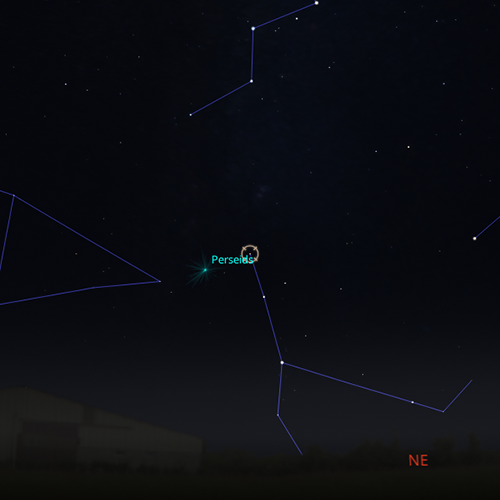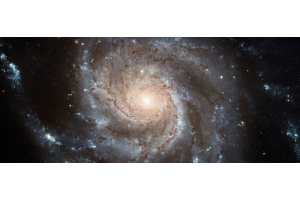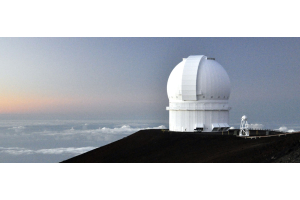
The Perseid meteor shower, widely considered to be one of the best celestial spectacles of the year (although perhaps shadowed by the earlier April 8, 2024, solar eclipse), graces the mid-August skies this year with its incredible celestial display. With its swift and luminous meteors, the Perseids are sure to impress stargazers and photographers alike! The Perseids are also renowned for their captivating fireballs, also known as “boldies”, explosions of light and color that linger in the sky, adding an extra layer of beauty to the experience.
The Perseids originate from Comet 109P/Swift-Tuttle, which has an orbital period of roughly 133 years. The Earth passes through the debris from this periodic comet once a year, and the debris burns up in our atmosphere, creating this spectacle in the sky. Their radiant, or point of origin, can be found in the constellation of Perseus, thus the origin of the name “the Perseids”.
As the eagerly anticipated peak of the Perseid meteor shower approaches in 2024, consider this a comprehensive guide for photography enthusiasts. We’ll be talking about ways to photograph the Perseids with a DSLR/mirrorless camera, or even your smartphone, for your friends and family to enjoy!
Understanding the Perseid Meteor Shower
The Perseid meteor shower is an annual celestial event that occurs when Earth passes through the debris trail left by Comet Swift-Tuttle. Named after the constellation Perseus, from which their radiant is located, the Perseids are usually seen in the night sky typically from mid-July to late August, with their peak activity occurring around mid-August. This meteor shower has been observed for over 2,000 years, with historical records dating back to ancient Chinese, Japanese, and Roman civilizations.
What sets the Perseids apart from other meteor showers is their remarkable brightness and speed, making them one of the most impressive meteor showers of the year. The Perseids are known for producing swift and bright meteors that frequently leave long-lasting trails of light and color behind them as they streak through the atmosphere. For this reason, often describe the Perseids as among the most visually stunning meteor showers. The Perseids are also renowned for their occasional outbursts of bright fireballs—larger explosions of light and color caused by larger particles of cometary material entering the atmosphere.
The Perseids are characterized by their radiant location in the northeastern sky, near the constellation Perseus, during their peak. This radiant rises in the late evening, reaches its highest point around dawn, and is visible from both hemispheres. Observers can expect to see the highest concentration of meteors originating from this point during the peak hours of the shower.
When and Where to Watch in 2024
The Perseids are predicted to peak on August 12, 2024, at 14:00 UTC. This is roughly 2 PM Eastern time, which puts US observers at somewhat of a disadvantage compared to other readers across the globe. However, the Perseids will be putting on a multi-night display. The best viewing times will be on the mornings of August 11, 12, and 13, when the radiant is nice and high in the sky. Additionally, the Moon will have set by morning, as it will be approaching first quarter by the night of the 13th.
The radiant rises in the middle of the night and is highest at dawn. To find the radiant, look towards the “M” that makes up the constellation of Cassiopeia. Below Cassiopeia is the constellation of Perseus, and the radiant is near the “tip” of Perseus near the star Miram. As a side note, the beautiful clusters that make up the Double Cluster are almost directly between these two constellations and would make a beautiful composite with any meteors you might photograph!

How to Photograph the Perseid Meteor Shower
Choosing the right location for observing and photographing the Perseid meteor shower is the single most important aspect of photographing the Perseids, next to time, of course. You need to get away from the bright cities and light pollution. It also helps, for photographic purposes, if you can find some sort of appealing foreground subject. An old barn, a single tree in a field, or something to that effect can often make for dramatic effects and can make for appealing subjects in your photography.
Now, let’s talk about gear. The easiest way to get a photograph of the meteor shower is with some sort of digital camera, preferably a DSLR or mirrorless. However, it is possible to do it with your smartphone. Find an app on your smartphone that enables you to take 20-30” exposures and save photographs in your camera’s native RAW format. Place your phone on some sort of sturdy object, like a rock or the side of your car, vaguely pointed towards the radiant, and set for multiple 30” exposures. Over time, you should be able to capture at least a few.
The same principle applies to DSLR/mirrorless cameras. However, your life can be made a little easier by using a tripod. Even the steadiest hands aren’t capable of holding your camera still enough for the time needed to get clear shots. Again, you might be able to prop your camera up against something around you, but be sure to have a secure camera. You’ll need a super wide angle lens, too, at least 24mm, to be able to get shots of the meteor shower. This is because the meteors, while they appear to originate from the radiant, will streak across the entire sky and won’t be confined to one space. We recommend a 14mm lens for this type of photography.

Now, a tripod does a great job of minimizing the camera shake; however, pressing the shutter can still cause issues during long exposures. Using the self-timer built into your camera allows for a short pause after pressing the shutter, effectively eliminating any chance of camera blur. Alternatively, a shutter release cable removes the necessity of having to touch the camera at all. Furthermore, if your camera supports Wi-Fi, you can remotely trigger the shutter using a mobile device.
In low-light conditions, autofocus struggles to find a subject to focus on, and we strongly recommend using manual focus instead. Otherwise, you may have blurry stars. Adjusting the focus to infinity is a starting point, but fine-tuning is often necessary. Mount your camera on a tripod and capture a test image with a few seconds of exposure. Review the image on the camera's screen, zooming in on a star to gauge focus accuracy. If stars appear blurry, make minor focus adjustments and capture another test image. Repeat this process until satisfied. If your camera features a zoomable electronic viewfinder or live view function, you may be able to focus directly on a star without the need for test images. Just get that star as small as possible, and you will be in good focus for the night!
But how long of an exposure do you need? As the Earth rotates, stars in the night sky seem to move, potentially causing streaks in your photos if the shutter remains open for too long. To minimize this effect, we recommend experimenting with the 500 Rule. Simply divide 500 by the focal length of your lens in millimeters. The quotient represents the maximum duration in seconds for which you can leave your shutter open without noticeable star trails. For instance, with a 14 mm lens, the longest exposure time before star trails become apparent is 35 seconds (500 divided by 14 is roughly 35-36 seconds).
Capturing the mesmerizing Perseid meteor shower can be a thrilling and rewarding experience for both stargazers and photography enthusiasts alike. Remember, finding the perfect location away from light pollution and selecting the right gear, whether it's a DSLR, mirrorless camera, or even your smartphone, can greatly enhance your photography experience. Utilizing tools like tripods, self-timers, and manual focus adjustments can help you achieve clearer and more captivating shots of the Perseids streaking across the night sky.
And while technical details like exposure times and focal lengths are important considerations, don't forget to enjoy the breathtaking beauty of the Perseid meteor shower. Even if your photographic results aren't perfect, the experience of witnessing this cosmic spectacle firsthand is truly unforgettable.
So, as the eagerly anticipated peak of the Perseid meteor shower approaches, I encourage you to venture outdoors, set up your camera, and capture the magic of the Perseids dancing across the heavens. Happy shooting, and may your photographs of this celestial marvel be as stunning as the event itself!

Learn More
Interested in learning more about astronomy and astrophotography? Not sure where to begin? Check out our Astronomy Hub!











